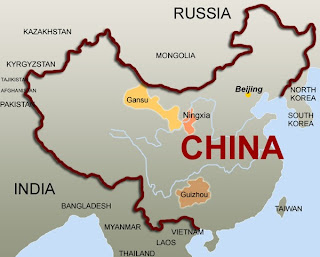The Washington Post
written by AP staff
Monday July 22, 2013
BEIJING — A strong earthquake that shook an arid, hilly farming area in northwest China sparked landslides and destroyed or damaged thousands of brick-and-mud homes Monday, killing at least 75 people and injuring more than 400, the government said.
The quake near the city of Dingxi in Gansu province toppled brick walls and telephone lines, shattered mud-and-tile-roofed houses and sent cascades of dirt and rock down hillsides that blocked roads and slowed rescue efforts by crews trying to reach remote areas.
Hospitals set up aid stations in parking lots to accommodate large numbers of injured, while hundreds of paramilitary People’s Armed Police fanned out to search for victims in the region of terraced farmland where the quake struck about 1,200 kilometers (760 miles) west of Beijing.
“I saw the bulb hanging from the ceiling start swinging wildly around. I woke my two friends and we ran into the bathroom to hide,” said arts student Li Jingui, 21, who was on the fourth floor of a school dormitory in Dingxi when the shaking started.
“After the strongest tremors were over, we were worried that there would be aftershocks so we packed our stuff and ran out into a large clearing,” Li said in a telephone interview.
In addition to the 75 confirmed dead, there were 14 people missing and 459 injured, the central government’s China Earthquake Administration said.
Damage was worst in Min county in Dingxi’s rural southern portion, where scores of homes were damaged and telephone and electricity services knocked out, Dingxi Mayor Tang Xiaoming told state broadcaster CCTV. All but three of the deaths, all the missing and most of the injured were in Min, a likely result of shoddy construction.
Residents said the shaking lasted about one minute, but wasn’t strong enough to cause major damage in urban areas, where buildings are more solidly built.
“You could see the chandeliers wobble and the windows vibrating and making noise, but there aren’t any cracks in the walls. Shop assistants all poured out onto the streets when the shaking began,” said a front desk clerk at the Wuyang Hotel in the Zhang County seat about 40 kilometers (25 miles) from the epicenter. The clerk surnamed Bao refrained from identifying herself further, as is common among ordinary Chinese.
Tremors were felt in the provincial capital of Lanzhou 177 kilometers (110 miles) north, and as far away as Xi’an, 400 kilometers (250 miles) to the east.
The government’s earthquake monitoring center said the initial quake at 7:45 a.m. (2345 GMT Sunday) was magnitude-6.6 and subsequent tremors included a magnitude-5.6.
The quake was shallow, which can be more destructive. The center said it struck about 20 kilometers (12.4 miles) beneath the surface, while the Gansu provincial earthquake administration said it was just 6 kilometers (3.7 miles) deep. The U.S. Geological Survey measured the magnitude of the initial quake as 5.9 and the depth at 10 kilometers (6 miles).
Initial measurements of an earthquake can vary widely, especially if different monitoring equipment is used.
Su Wei, leader of a 120-member rescue team from the paramilitary People’s Armed Police, told state broadcaster CCTV that they were on their way to the epicenter, but progress was being slowed by mud and rock slides blocking the road.
The Chinese Red Cross said it was shipping 200 tents, 1,000 sets of household items, and 2,000 jackets to the area and sending teams from both Lanzhou and Beijing to help with relief work and assess further needs.
Heavy rain is expected in the area later in the week, raising the need for shelter and increasing the chance of further landslides.
Almost 2,000 homes were either destroyed or heavily damaged, with thousands more suffering partial damage, according to the Dingxi government website. It said 14,066 households were without power and five county and township roads had been cut.
Gansu province, a region of mountains, desert and pastureland with a population of 26 million, is one of China’s more lightly populated provinces, although the New Jersey-sized area of Dingxi has a greater concentration of farms in rolling hills terraced for crops and fruit trees. Dingxi has a total population of about 2.7 million.
China’s worst earthquake in recent years was a 7.9-magnitude temblor that struck the southwestern province of Sichuan in 2008, leaving 90,000 people dead or missing.






































No comments:
Post a Comment